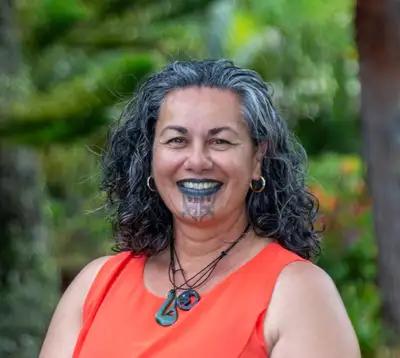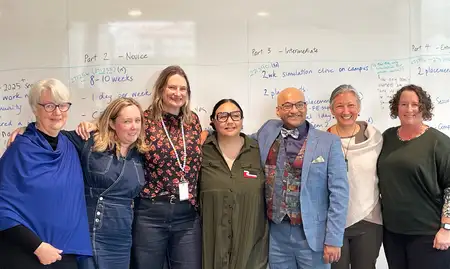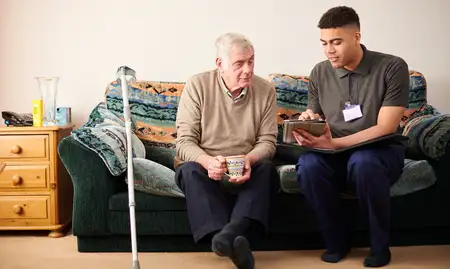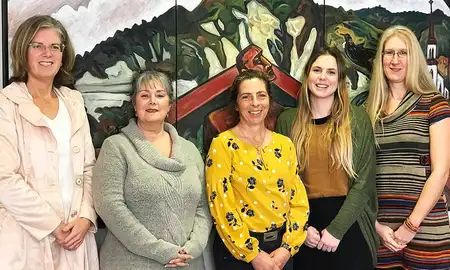
Weaving as therapy promotes relaxation, mindfulness and emotional expression while enhancing fine motor skills, focus and cognitive function.
Integrating weaving as a part of counselling is very multilayered and multi-dimensional. Each element of a korowai or a kahu huruhuru represents every area of the person, their strengths, challenges, values and belief systems, their mind, body, spirit and soul and how each of these aspects links to other relationships in their lives. There is no hiding when our hands and mind are kept busy.
The word kōmiri, when broken down is: kō – to korero and also a digging stick for the garden, and miri - to agitate and stimulate the internal waters, muscles, body and mind. Put together, kōmiri is Indigenous pluralistic counselling that stimulates deeper conversations and emotions, that invites healing of the physical, psychological and/or mental ailments to bring about change and healing.
Weaving as therapy promotes relaxation, mindfulness and emotional expression while enhancing fine motor skills, focus and cognitive function. It fosters self-esteem, patience and a sense of accomplishment. The tactile nature provides sensory stimulation, and group weaving encourages social connection and community building.
In some ways, kōmiri could be likened to art or music therapy, where the artist incorporates the spiritual vibration of their ancestors to access the knowledge and skills within their own hands, to create meaning and understanding with their masterpiece. This is the korowai of pluralistic counselling, bringing together the multiple layers of whānau lives that include who they are and who they come with – their tīpuna or ancestors.
As a teacher in counselling and guidance education in the Institute of Education within Te Tiriti o Waitangi-led Te Kunenga ki Pūrehuroa Massey University, I encourage students to bring all of themselves into the counselling space as I do when I walk alongside whānau on their journey to health and wellbeing.
For me, this makes me a better counsellor, educator and practitioner by making deeper connections. For counsellors-in-training, this allows them to draw on their own lived experiences and strengths thereby enhancing relationships through whakapapa narratives which can then potentially be applied to practice.
In my own practice, I utilise rongoa, mirimiri, pūrākau and weaving alongside the kōmiri, I utilise my knowledge, skills and strengths to better support whānau. They know, from the very first whanaungatanga hui, what they can expect from me. No two sessions are the same. How I bring wairuatanga and weaving into the kōmiri space will be different to you and that is a great thing.
What I have noticed when bringing these modalities into the counselling space is that there is no place for the whānau to hide – this is a brave space that can be upfront, raw and challenging, yet healing on a physical, spiritual, celestial and terrestrial level.

Professional Clinician Joyce Manahi
When working with couples, mirimiri allows for a non-threatening way of communicating; there is no way out but to communicate with each another. Couples may start off by not making eye contact and by the end of the session there is not only eye contact, there may also be tears, good or bad.
Pūrākau are woven throughout the sessions (where appropriate) and support whānau to internalise and externalise connections, make meaning, understand and give purpose to their situation and lives. Within this, poutauwhiro are able to weave their counselling modalities and theories into their practice, all of which benefit whānau.
The wero or challenge is for poutauwhiro, counsellors and counsellors-in-training to find where their strengths lie, what their pūrākau are and to be courageous in bringing all of themselves into the counselling space.
Joyce Manahi is Professional Clinician from the Institute of Education.
Glossary
- Korowai is a cloak with little or no feathers and may be adorned with hukahuka or tassels
- Kahu huruhuru is a cloak covered in feathers
- Rongoā is a traditional Māori healing system encompassing herbal remedies, physical therapies, and spiritual healing, focusing on holistic well-being and the connection to the natural world
- Mirimiri is a traditional Māori healing modality that uses bodywork and pressure point techniques to restore balance and well-being to the body, mind, and spirit
- Poutauwhiro is a name used for counsellor or social worker
- Pūrākau are Māori stories, myths, legends and oral histories that are passed down through generations
- Wairuatanga is spirituality or the spiritual dimension of a person or place, encompassing beliefs, values, and cultural practices.
Related news
Innovative Speech Language Therapy programme undergoes professional accreditation site visit
Te Kunenga ki Pūrehuroa Massey University’s Speech Language Therapy programme has gone through a professional accreditation site visit by the New Zealand Speech-language Therapists’ Association.

Spotlight on staff success at Auckland graduation
This week saw more than 1000 graduates crossing the stage at Tāmaki Makaurau Auckland’s Bruce Mason Centre, including 13 staff members.

Speech Language Therapy programme now more widely accessible
Te Kunenga ki Pūrehuroa Massey University is shifting its training programme online from 2024 so it becomes accessible to all students no matter where they live.

Low-cost therapy for anxiety sufferers
Centre for Psychology staff at the Auckland campus are offering anxiety sufferers low-cost group therapy programmes in the Albany Village next month.
